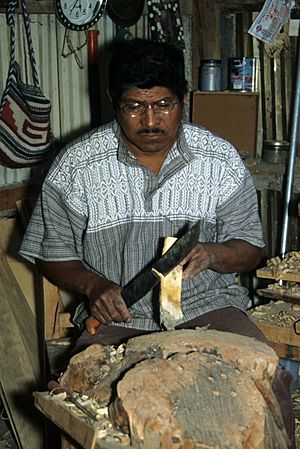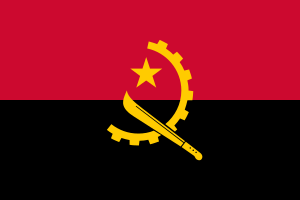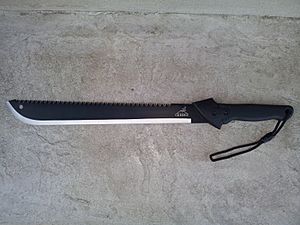Machete facts for kids

A machete is a tool with a wide blade. It can be used for farming, like a small axe, or sometimes as a long knife in battles. The blade is usually about 30 to 45 centimeters (12 to 18 inches) long. It is also quite thin, usually less than 3 millimeters (about 1/8 inch) thick.
The word "machete" comes from the Spanish language. It might be a smaller version of "macho," which means "sledgehammer." Another idea is that it comes from "machaera," a type of sword used by the ancient Greeks and Romans. In many English-speaking Caribbean countries, like Jamaica and Trinidad and Tobago, people call this tool a "cutlass."
Contents
How Machetes Are Used
In Farming and Daily Life
Machetes are very common in tropical and subtropical countries. People often use them to cut through thick plants in rainforests. They are also used in farming, for example, to cut down sugar cane.
In Latin America, machetes are used for many everyday tasks at home. They can cut large foods into smaller pieces, much like a cleaver. They are also used for simple cutting jobs, like making wooden handles for other tools. It's common to see people using machetes to open coconuts, do yard work, remove small branches, chop food for animals, and clear bushes.
Machetes are usually seen as tools for adults. However, in some cultures where people gather food or farm to feed themselves, children learn to use sharp tools, including machetes, from a very young age.
In History and Conflicts
Machetes have sometimes been used by people in uprisings or conflicts. For example, a group in Puerto Rico, the Boricua Popular Army, is sometimes called macheteros. This name comes from the sugar cane workers who used machetes in the past.
Machetes were also used during the 1994 Rwandan genocide by militias. In Haiti, the Tonton Macoute also used machetes as a tool and weapon.
In 1762, the British took over Havana during the Seven Years' War. Local volunteer fighters, led by Pepe Antonio, used machetes to defend the city. Machetes were also important during Cuba's fight for independence. Carlos Manuel de Céspedes freed his slaves in 1868 and led them, armed with machetes, against the Spanish government. Later, Máximo Gómez led the first cavalry charge using machetes as the main weapon in 1868.
Machetes are also common tools and side weapons for many groups in West Africa. The writer Chinua Achebe mentions machetes in his book Things Fall Apart.
Some countries have special words for hitting someone with a machete. In Spanish, machetazo means a blow from a machete. In some Caribbean islands, "planass" means to hit someone with the flat side of the blade, while "chop" means to hit with the sharp edge.
The Brazilian Army has a special machete-style knife for jungle training. It has a 10-inch (25 cm) blade and a sharp point. This machete comes with a small Bowie knife and a sharpening stone in its cover. This set is called a "jungle kit."
Machetes were also used in the Mau Mau rebellion and in South Africa during conflicts in the 1980s and 1990s.
How Machetes Are Made
Good machetes depend on the materials they are made from and their shape. In the past, a very famous company that made machetes for Latin America and the Spanish-speaking Caribbean was Collins Company from Collinsville, Connecticut. This company started in 1826 to make axes. They began selling machetes in 1845, and their machetes became so well-known that people sometimes called any machete un collin. In the English-speaking Caribbean, Robert Mole & Sons from England was known for making the best farming cutlasses.
Today, Colombia is the biggest exporter of machetes around the world.
Machetes in Culture

The flag of Angola shows a machete along with a cog-wheel, which represents workers and agriculture.
In the southern Brazilian state of Rio Grande do Sul, there is a dance called the dança dos facões (machetes' dance). In this dance, men hit their machetes against different surfaces while dancing, pretending to be in a battle. Maculelê, an Afro-Brazilian dance and martial art, can also be performed with facões (machetes). This dance started in the city of Santo Amaro, Bahia.
In the Philippines, a tool called the bolo is used in training for eskrima, which is a Filipino martial art.
Similar Tools
The panga or tapanga is a type of machete used in East and Southern Africa. This name might come from the Swahili language. The panga blade is wider at the back and is about 16 to 18 inches (40 to 45 cm) long. The top part of the blade can also be sharpened.
Other tools that are similar include the parang and the golok from Malaysia and Indonesia. These tools usually have shorter, thicker blades and are better for cutting woody plants.
The tsakat is a similar tool used in Armenia to clear land of plants.
Other tools like the machete are:
- Billhook
- Dusack
- Golok
- Kopis
- Kukri
- Macuahuitl
- Seax
- Sorocaban Knife
Images for kids
See also
 In Spanish: Machete para niños
In Spanish: Machete para niños





